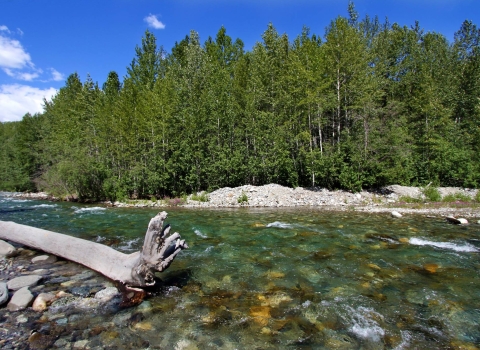Press Release
Effects of Climate Change on Wildlife and Habitat Concern Most Visitors to National Wildlife Refuges
Visitors to national wildlife refuges are concerned about the impact of climate change climate change
Climate change includes both global warming driven by human-induced emissions of greenhouse gases and the resulting large-scale shifts in weather patterns. Though there have been previous periods of climatic change, since the mid-20th century humans have had an unprecedented impact on Earth's climate system and caused change on a global scale.
Learn more about climate change on America's fish, wildlife and plants as well as the habitat that supports them, a new survey just released by the U.S. Fish and Wildlife Service shows. The survey also shows strong support for efforts to help native species adapt to changing climate conditions, such as those now being implemented by the Service and its partners. Seventy-one percent of the more than 10,000 visitors to national wildlife refuges who took part in the survey conducted by the U.S. Geological Survey in 2010 and 2011 believe that climate change poses a serious threat to wildlife and wildlife habitat. About 74 percent of the same respondents agree that addressing climate change effects on wildlife and wildlife habitats will benefit future generations. "The results of this survey underscore the Service's responsibility entrusted to us by the American people to ensure that we use the best science to understand and anticipate the impacts of a changing climate in order to safeguard fish, wildlife and plants and the important benefits and services they provide," said Service Director Dan Ashe. "We recognize the serious threats that climate change and other environmental stressors pose to wildlife, and we're working with our partners to address these immense challenges using the latest science-driven approaches. Significant climate-related impacts on fish and wildlife have already been observed by scientists across North America. These impacts include dramatic shifts in the range of dozens of species and altered precipitation patterns, resulting in increased flooding in some areas and drought and water scarcity in others. In addition, flowers are blooming earlier in the spring, while lakes are freezing later in the fall. These shifts have disrupted the migration patterns of birds, as well as the food chain on which they and many other species depend. Ashe noted that the Service's statutory authorities do not give the agency the ability or responsibility to regulate the causative factors of climate change. However, those authorities do require the Service to work with the conservation community to anticipate and manage for the impacts of climate change on fish and wildlife resources as the agency is required to address any other factor affecting the long-term health and abundance of these resources. The Fish and Wildlife Service is working with its partners to address the impacts of climate change on fish, wildlife and plants and the communities that depend on them. These efforts include: * As directed by Congress, leading development of a National Fish, Wildlife and Plants Climate Adaptation Strategy designed to guide government-wide wildlife adaptation partnerships over the next 50 to 100 years. * Developing an innovative carbon sequestration program in the Lower Mississippi Valley in partnership with the Conservation Fund, American Electric Power Company, and Entergy Inc., that is also restoring native habitats to bolster populations of wildlife and migratory birds. The project has added more than 40,000 acres of habitat to the National Wildlife Refuge System and reforested more than 80,000 acres, sequestering 30 million metric tons of carbon over the project's 70-year lifetime. * Helping to create a network of locally-driven, solution-oriented Landscape Conservation Cooperatives that will allow federal, state and local partners to develop shared science capacity to inform conservation actions that help priority species and habitats withstand the impacts of climate change. "As we look to the future, the Refuge System will need to prioritize land restoration to effectively sequester carbon and protect wildlife," said Refuge System Chief Jim Kurth. "That means targeted restoration to bring altered landscapes into balance and to protect habitats that support viable populations of wildlife. Most importantly, we have to work with other government agencies, non-profit organizations and private landowners to face the challenge of climate change." The National Wildlife Refuge System, managed by the Service, is the nations premier system of public lands and waters set aside to conserve wildlife and wildlife habitat. National wildlife refuges protect thousands of species; many also are popular recreation sites, noted for their hunting and fishing, paddling and hiking, and wildlife observation. Other survey results show that more than half of the refuge visitors surveyed indicated a high level of both interest and personal involvement in climate issues. More than two-thirds of respondents (69 percent) agreed that addressing climate change impacts could "improve our quality of life." Nearly half of visitors surveyed (46 percent) expressed interest in learning from refuges what they could do to help address the effects of climate change on wildlife and habitat. Economic considerations factored into visitors assessments of climate change impacts. More than two-thirds (71 percent) agreed that it is important to consider the economic costs and benefits to local communities when addressing climate change effects on fish, wildlife and habitats." USGS social scientist Natalie Sexton was the lead researcher on the report. The USGS designed, conducted, analyzed and reported on the peer-reviewed survey. The survey is available here.
Climate change includes both global warming driven by human-induced emissions of greenhouse gases and the resulting large-scale shifts in weather patterns. Though there have been previous periods of climatic change, since the mid-20th century humans have had an unprecedented impact on Earth's climate system and caused change on a global scale.
Learn more about climate change on America's fish, wildlife and plants as well as the habitat that supports them, a new survey just released by the U.S. Fish and Wildlife Service shows. The survey also shows strong support for efforts to help native species adapt to changing climate conditions, such as those now being implemented by the Service and its partners. Seventy-one percent of the more than 10,000 visitors to national wildlife refuges who took part in the survey conducted by the U.S. Geological Survey in 2010 and 2011 believe that climate change poses a serious threat to wildlife and wildlife habitat. About 74 percent of the same respondents agree that addressing climate change effects on wildlife and wildlife habitats will benefit future generations. "The results of this survey underscore the Service's responsibility entrusted to us by the American people to ensure that we use the best science to understand and anticipate the impacts of a changing climate in order to safeguard fish, wildlife and plants and the important benefits and services they provide," said Service Director Dan Ashe. "We recognize the serious threats that climate change and other environmental stressors pose to wildlife, and we're working with our partners to address these immense challenges using the latest science-driven approaches. Significant climate-related impacts on fish and wildlife have already been observed by scientists across North America. These impacts include dramatic shifts in the range of dozens of species and altered precipitation patterns, resulting in increased flooding in some areas and drought and water scarcity in others. In addition, flowers are blooming earlier in the spring, while lakes are freezing later in the fall. These shifts have disrupted the migration patterns of birds, as well as the food chain on which they and many other species depend. Ashe noted that the Service's statutory authorities do not give the agency the ability or responsibility to regulate the causative factors of climate change. However, those authorities do require the Service to work with the conservation community to anticipate and manage for the impacts of climate change on fish and wildlife resources as the agency is required to address any other factor affecting the long-term health and abundance of these resources. The Fish and Wildlife Service is working with its partners to address the impacts of climate change on fish, wildlife and plants and the communities that depend on them. These efforts include: * As directed by Congress, leading development of a National Fish, Wildlife and Plants Climate Adaptation Strategy designed to guide government-wide wildlife adaptation partnerships over the next 50 to 100 years. * Developing an innovative carbon sequestration program in the Lower Mississippi Valley in partnership with the Conservation Fund, American Electric Power Company, and Entergy Inc., that is also restoring native habitats to bolster populations of wildlife and migratory birds. The project has added more than 40,000 acres of habitat to the National Wildlife Refuge System and reforested more than 80,000 acres, sequestering 30 million metric tons of carbon over the project's 70-year lifetime. * Helping to create a network of locally-driven, solution-oriented Landscape Conservation Cooperatives that will allow federal, state and local partners to develop shared science capacity to inform conservation actions that help priority species and habitats withstand the impacts of climate change. "As we look to the future, the Refuge System will need to prioritize land restoration to effectively sequester carbon and protect wildlife," said Refuge System Chief Jim Kurth. "That means targeted restoration to bring altered landscapes into balance and to protect habitats that support viable populations of wildlife. Most importantly, we have to work with other government agencies, non-profit organizations and private landowners to face the challenge of climate change." The National Wildlife Refuge System, managed by the Service, is the nations premier system of public lands and waters set aside to conserve wildlife and wildlife habitat. National wildlife refuges protect thousands of species; many also are popular recreation sites, noted for their hunting and fishing, paddling and hiking, and wildlife observation. Other survey results show that more than half of the refuge visitors surveyed indicated a high level of both interest and personal involvement in climate issues. More than two-thirds of respondents (69 percent) agreed that addressing climate change impacts could "improve our quality of life." Nearly half of visitors surveyed (46 percent) expressed interest in learning from refuges what they could do to help address the effects of climate change on wildlife and habitat. Economic considerations factored into visitors assessments of climate change impacts. More than two-thirds (71 percent) agreed that it is important to consider the economic costs and benefits to local communities when addressing climate change effects on fish, wildlife and habitats." USGS social scientist Natalie Sexton was the lead researcher on the report. The USGS designed, conducted, analyzed and reported on the peer-reviewed survey. The survey is available here.


